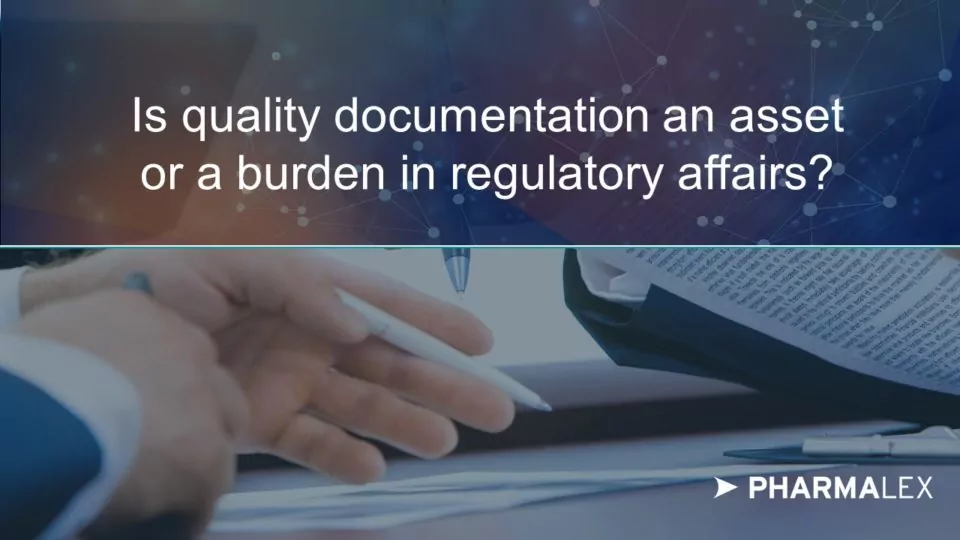Martin Knieps-Hastenrath
Quality documentation (QD) defined under GxP principles is a requirement for many departments/functions within the pharmaceutical industry. But in the crucial area of Regulatory Affairs (RA), there is usually very little incentive to commit resources to detailed quality documentation, with most seeing it as a burden rather than a strategic asset.
One area of particular note is training, where approaches based solely on QDs are outdated, don’t reach the right target group in- and outside of RA or are not understood. The challenge is there has been no real commitment to investing the time and effort in maintaining updates to training material. There are several reasons for this, including that modern training approaches must cope with increasing employees’ expectations of on-demand knowledge delivery and interactive training; that the target group for the QD training is constantly changing in line with changes in the organization; or because of the time involved in updating the QD.
Currently the overall number of QDs in RA is historically high in a lot of global pharmaceutical companies. RA would do well to consider strategies, such as to develop less rigid but no less valuable documentation on business processes and for training outside the Quality Management System instead of further investing in QDs where not needed and to design smart QDs only when needed. This will enable RA to save costs and time in the mid-term.
Consider the main driver for changes in RA
The difference between RA and other functions is that the legislation refers to what has to be done and even the timelines in which data and information must be delivered to Health Authorities. The how has usually been defined in rather technical or content guidance, with the technical requirements rapidly increasing in the digital area (see blog on Navigating New Digital Regulatory Requirements). But how exactly to most effectively achieve a submission-ready dataset or dossier has still been a matter of flexible internal processes and operating models matching these requirements. This flexibility in the “how” aspect of RA explains why there has been little impetus when it comes to developing QD.
Global pharmaceutical companies are constantly trying different operating models to determine which is most efficient for the business – e.g. from handling everything at a global level to moving to local or regional reporting to sending everything to low cost offshore hubs.
From the QD management perspective a core question is whether it is principles or processes that are impacted by a change or rather the operating model. For example, while there may be major regulatory developments, the high-level principles and processes of how to prepare a dossier or a dataset for a regulatory submission have not changed for many years.
To save resources, documentation in RA requires a smart design
Indeed, quality documentation might even present hurdles for RA due to the fact that it must be maintained within the quality system, which means every process deviation, every change in operation model, every adaptation to KPIs in the QDs has to be reported, justified, and documented.
Many companies define/specify internal timelines and key performance indicators in their QD. The question is, why? Recording and tracking all these data and non-core process-related changes in the QD is pointless and time-consuming because it means the QD has to be continuously – yet unnecessarily — updated. Ideally, companies should establish a target timeline rather than a fixed timeline to avoid falling into non-compliance if a timeline isn’t met and should avoiding defining internal KPIs in their QDs.
Instead, companies would do well to develop documentation for RA outside the Quality Management System to identify the activities that need to be carried out whenever there is a change to the operating model, the KPIs or the target timelines, with the relevant change information communicated through these supplemental documents.
The objective should be to steer the workforce to support a defined operating model and to work to meet timelines and KPIs while ensuring the business isn’t locked into a rigid approach that will require constant and ongoing documentation updates.
Focus on Documenting and Optimizing processes
The best practice processes described might best be understood through an example.
A biopharma company sought to find ways to better manage its processes. The organization had implemented a Lean Six Sigma business process management approach that it wanted to introduce across the entire business area. The challenge was that the process didn’t fit seamlessly with the way RA operates. Unlike other functions, RA doesn’t run linear work processes. Regulatory activities are not generally handled in defined consecutive steps, so the department requires flexibility to carry out activities as required – sometimes sequentially, sometimes in parallel and not always in the same order.
From a resource perspective, regulatory activities require different roles and responsibilities, a submissions expert, someone with local knowledge, a strategist, a person to plan the submission and so on. The challenge was how to put this on paper without creating barriers and limitations for the department. The solution was to thoroughly define single processes but keep the connection points of the processes flexible. This allows for the flexibility between the workstreams while ensuring the processes required for successful preparation of a submission remain clearly defined.
This is a gamechanger for RA since it ensures the objectives of business process management are met while allowing for flexibility in terms of how the regulatory team works and carries out activities.
Managing this more flexible and efficient approach within the context of Six Sigma ensured the whole approach began with a better understanding of the function and how it operates by asking key questions: Why does this process need to be run? What are the goals and outputs when running this process? How does the process need to proceed? And how can or should efficacy and efficiency be measured?
People first
As companies look at how best to move forward with their process documentation, top of mind with the operating model should be how people within the function operate and develop processes to meet those needs. What expertise do the employees have and how is it used? How can that knowledge be maintained and developed? And how can the organization ensure its people are appropriately trained? It starts with having the best training concepts in place to enable employees to carry out the processes, rather than requiring people to adapt to the processes.
Given the limitations quality documentation can impose if a company incorporates all activities and operating models, it’s advisable to take a more holistic change approach to optimization processes and their documentation, QD management and trainings in RA. This should include:
- Map the RA process landscape
- Determine which processes have to be covered in QDs, limiting the number of QDs
- Before adapting the documentation, evaluate how people are trained on processes and QDs and how that training is perceived
- Determine how compliant employees are to what is written in the documentation and whether they understand the process
- Determine how to improve the training approach and the processes
- Adapt the documentation
- Implement
About the author:
Martin Knieps-Hastenrath, Director, Principal Consultant, Regulatory Affairs at PharmaLex, has 15 years of experience in RA with focus on interfaces in post-marketing surveillance. Martin is a biologist/biochemist by training with deep understanding of the expert requirements regarding proper regulatory document, system and information management.








